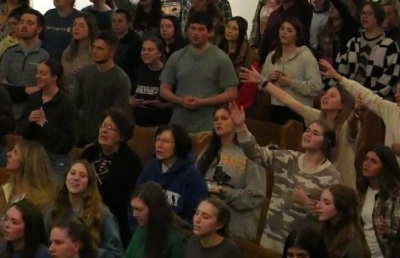History tells us there's no such thing as a perfect revival, but ...

As a church historian, it has been interesting to see how Christians have responded to the recently concluded revival at Asbury University. Some people thanked God for the outpouring of His spirit, while others cautiously encouraged the revival but warned that only time will tell if this bears fruit.
Then there are the naysayers.
The charges leveled against this revival ranged from not teaching repentance of Asbury’s egalitarian position to delegitimizing its value because there is not an overt antiracist message. There were also the typical charges of emotionalism and lack of preaching. This is not surprising. Jonathan Edwards wrote several works defending the First Great Awakening against people who discredited that revival because it did not meet their criteria. He also articulated the differences between genuine revival and false spirituality.
A look at the history of revivals teaches us that if we are looking for a perfect revival or a perfect revivalist who meets our specific criteria, we will not find them. But God uses them.
During the First Great Awakening in the early 18th century, the birth of the evangelical movement took place outdoors at Second and Market streets in Philadelphia, at Boston Common, and up and down the eastern seaboard, when itinerant preacher George Whitefield took the colonies by storm with his message of the new birth. We learn from Benjamin Franklin that Whitefield was not allowed to speak in many churches in Philadelphia because clergy disagreed with his message, so Whitefield took to the streets. Prior to these revivals, Edwards witnessed a revival in his own church in Northampton, Conn., and received attacks from fellow clergy.
If we were to judge the First Great Awakening by some criteria being used on social media today, we would say it was a failure, because Jonathan Edwards never repented of owning African slaves, and Whitefield never repented of using slaves to build his orphanage in Georgia. But by doing that, we fail to see that it was during this revival when African-Americans began embracing Christianity in large numbers, even though Whitefield spoke blocks from one of Philadelphia’s slave markets.
Second, while Edwards could not see the sin of race-based chattel slavery, the young men of New England who were impacted by the revivals and studied with Edwards, including Jonathan Edwards Jr., went on to apply his father’s theology to oppose slavery. Another of Edward’s students, Samuel Hopkins, wrote to the Constitutional Congress asking for slavery to be outlawed.
Throughout the first half of the 19th century was a series of revivals known as the Second Great Awakening. Theologians have been critical of some of these revivals because of chief architect Charles Finney’s use of new measures that attempted to create revival with theatrics, prolonged services, decisionism, and a guilt-inducing preaching style.
These revivals led to some false conversions and a region of America in upstate New York to be referred to as the Burned-Over District. But not all revivals had Finney’s stamp, and 19th-century revivalism helped birth the abolitionist movement, the temperance movement, the Sunday school movement, public education, and women’s rights.
After an economic downturn, revivals erupted on Wall Street, known as the Businessmen’s Revivals of 1857-58. These revivals emerged with the sectional tensions in America at a fever pitch. Christians hoped that a revival would heal the nation, so they refused to allow slavery to be mentioned during the services because it was too divisive.
Of course, these revivals did not heal America and instead avoided the big elephant in the room, but it was during these events that the Holiness Movement made inroads in mainline evangelicalism, social reform grew, and denominations worked together. During the Civil War, revival also regularly took place in both Union and Confederate army camps.
Despite all the revivalism of the 19th century, Americans did not collectively repent of racism or slavery, and for some naysayers, this made them a failure. Had they led to that type of repentance, America would be a better place, and hundreds of thousands of men would not have died. After four years of bloodshed, in 1867, the Holiness Movement was birthed in Vineland, N.J.
The history of revivalism teaches us that revivals don't eradicate all sins — glaring ones nor our pet ones. In fact, not all Christians see the need for the same repentance. Edwards understood the complexity of revivalism and repentance when he wrote in Religious Affections, “… it is a mysterious thing, and what has puzzled and amazed many a good Christian, that there should be that which is so divine and precious, as the saving grace of God, and the new and divine nature dwelling in the same heart, with so much corruption, hypocrisy, and iniquity, in a particular saint. Yet neither of these is more mysterious than real. And neither of them is a new or rare thing.” Ironically, Edwards could write this and not see his own blind spots. None of this justifies unrepentant sin, but it does help explain it.
Before anyone judges this latest revival too quickly, they should be cautious and pray that it leads to repentance of personal and national sins. However, we should not expect our list of sins to be eradicated as we think they should.
If history and Scripture are our guides, we may not know how God will use this revival for a generation and that God’s ways are inscrutable.
Dr. Mark Draper is Director of Library Services and a faculty member at Lancaster Bible College | Capital Seminary & Graduate School. He earn his PhD in Historical Theology from Trinity Evangelical Divinity School, where he where he was Jonathan Edwards Fellow, along with two master’s degrees from Drexel University and Bible Seminary and a bachelor’s degree in history from Temple University. His research interests include the history of evangelicalism and 18th and 19th century evangelical social reformers and theologians such as Edwards, John Wesley and Gilbert Haven.




















